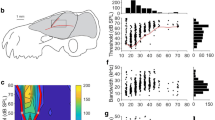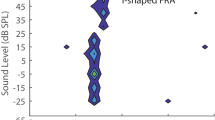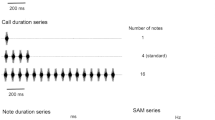Summary
Tonotopical organization and frequency representation in the auditory cortex of Greater Horseshoe Bats was studied using multi-unit recordings.
The auditory responsive cortical area can be divided into a primary and a secondary region on the basis of response characteristics forming a core/belt structure.
In the primary area units with best frequencies in the range of echolocation signals are strongly overrepresented (Figs. 6–8). There are two separate large areas concerned with the processing of the two components of the echolocation signals. In one area frequencies between the individual resting frequency and about 2 kHz above are represented, which normally occur in the constant frequency (CF) part of the echoes (CF-area), in a second one best frequencies between resting frequency and about 8 kHz below are found (FM-area).
In the CF-area tonotopical organization differs from the usual mammalian scheme of dorso-ventral isofrequency slabs. Here isofrequency contours are arranged in a semicircular pattern.
The representation of the cochlear partition (cochleotopic organization) was calculated. In the inferior colliculus and auditory cortex there is a disproportionate representation of the basilar membrane. This finding is in contradiction to the current opinion that frequency representation in the auditory system of Horseshoe Bats is only determined by the mechanical tuning properties of the basilar membrane.
Response characteristics for single units were studied using pure tone stimuli. Most units showed transient responses. In 25% of units response characteristics depended on the combination of frequency and sound pressure level used.
Frequency selectivity of units with best frequencies in the range of echolocation sounds is very high. Q-10dB values of up to 400 were found in a small frequency band just above resting frequency.
Similar content being viewed by others
Abbreviations
- BF :
-
best frequency
- CF :
-
constant frequency
- FM :
-
frequency modulated
- MT :
-
minimal threshold
References
Andersen RA, Knight PL, Merzenich MM (1980) The thalamocortical and corticothalamic connections of AI, AII, and the anterior auditory field (AAF) in the cat: evidence for two largely segregated systems of connections. J Comp Neurol 194:663–701
Asanuma A, Wong D, Suga N (1983) Frequency and amplitude representations in anterior primary auditory cortex of the Mustache Bat. J Neurophysiol 50:1182–1196
Bruns V (1976) Peripheral auditory tuning for fine frequency analysis by the CF-FM batRhinolophus ferrumequinum II. Frequency mapping in the cochlea. J Comp Physiol 106:87–97
Bruns V, Schmieszek E (1980) Cochlear innervation in the Greater Horseshoe Bat: Demonstration of an acoustic fovea. Hear Res 3:27–43
Casseday JH, Diamond IT, Harting JK (1976) Auditory path-ways to the cortex inTupaia glis. J Comp Neurol 166:303–340
Clopton BM, Winfield JA, Flammino FJ (1974) Tonotopic organization: Review and analysis. Brain Res 76:1–20
Hellweg FC, Koch R, Vollrath M (1977) Representation of the cochlea in the neocortex of Guinea pig. Exp Brain Res 29:467–474
Imig TJ, Ruggero MA, Kitzes LM, Javel E, Brugge JF (1977) Organization of auditory cortex in the owl monkey (Aotus trivirgatus). J Comp Neurol 171:111–128
Knudsen EI, Konishi M (1978) Space and frequency are represented seperately in the auditory midbrain of the owl. J Neurophysiol 41:870–884
Long GR, Schnitzler HU (1975) Behavioral audiograms from the batRhinolophus ferrumequinum. J Comp Physiol 100:211–220
Machmerth H, Theiss D, Schnitzler HU (1975) Konstruktion eines Luftschallgebers mit konstantem Frequenzgang im Bereich von 15–130 kHz. Acustica 34:81–85
McMullen NT, Glaser EM (1982) Tonotopic organization of rabbit auditory cortex. Exp Neurol 75:208–220
Merzenich MM, Kaas JH, Roth GL (1976) Auditory cortex in the grey squirrel: Tonotopic organization and architectonic fields. J Comp Neurol 166:387–402
Merzenich MM, Knight PL, Roth GL (1975) Representation of the cochlea within primary auditory cortex in the cat. J Neurophysiol 38:231–249
Möller J, Neuweiler G, Zöller H (1978) Response characteristics of inferior colliculus neurons of the awake CF-FM batRhinolophus ferrumequinum. J Comp Physiol 125:217–225
Neuweiler G (1970) Neurophysiologische Untersuchungen zum Echoortungssystem der Großen HufeisennaseRhinolophus ferrumequinum. Z Vergl Physiol 67:273–306
Neuweiler G (1980) Auditory processing of echoes: Peripheral processing. In: Busnel RG, Fish JF (eds) Animal sonar systems. Plenum Press, New York, pp 519–548
Neuweiler G, Vater M (1977) Response patterns to pure tones of cochlear nucleus units in the CF-FM batRhinolophus ferrumequinum. J Comp Physiol 115:119–134
Neuweiler G, Bruns V, Schuller G (1980) Ears adapted for the detection of motion, or how echolocating bats have exploited the capacities of the mammalian auditory system. J Acoust Soc Am 68:741–753
O'Neill WE, Suga N (1979) Target range-sensitive neurons in the auditory cortex of the Mustache Bat. Science 203:69–73
O'Neill WE, Suga N (1982) Encoding of target range and its representation in the auditory cortex of the Mustache Bat. J Neurosci 2:17–31
Ostwald J (1980) The functional organization of the auditory cortex in the CF-FM batRhinolophus ferrumequinum. In: Busnel RG, Fish JF (eds) Animal sonar systems. Plenum Press, New York, pp 953–955
Pollak GD, Bodenhamer RD (1981) Specialized characteristics of single units in inferior colliculus of Mustache Bat: frequency representation, tuning, and discharge patterns. J Neurophysiol 46:605–620
Pollak GD, Bodenhamer RD, Zook JM (1983) Cochleotopic organization of the Mustache Bat's inferior colliculus. In: Ewert JP, Capranica RR, Ingle DI (eds) Advances in vertebrate neuroethology. Plenum Press, New York, pp 925–935
Pollak GD, Schuller G (1981) Tonotopic organization and encoding features of single units in inferior colliculus of Horse-shoe Bats: Functional implications for prey identification. J Neurophysiol 45:208–226
Radtke S (1983) Interconnections of the auditory cortex and thalamus in the bat,Rhinolophus rouxi. Abstract: II. European Symposium on bat research, Bonn
Reale RA, Imig TJ (1980) Tonotopic organization in auditory cortex of the cat. J Comp Neurol 192:265–292
Schlegel P (1977) Directional coding by binaural brainstem units of the CF-FM bat,Rhinolophus ferrumequinum. J Comp Physiol 118:327–352
Schnitzler HU (1968) Die Ultraschall-Ortungslaute der Hufeisen-Fledermäuse (Chiroptera-Rhinolophidae) in verschiedenen Orientierungssituationen. Z Vergl Physiol 57:376–408
Schnitzler HU, Ostwald J (1983) Adaptations for the detection of fluttering insects by echolocation in horseshoe bats. In: Ewert JP, Capranica RR, Ingle DI (eds) Advances in vertebrate neuroethology. Plenum Press, New York, pp 801–827
Schuller G, Pollak G (1979) Disproportionate frequency representation in the inferior colliculus of Doppler-compensating Greater Horseshoe Bats: Evidence for an acoustic fovea. J Comp Physiol 132:47–54
Suga N (1965) Functional properties of auditory neurons in the cortex of echolocating bats. J Physiol (Lond) 181:671–700
Suga N (1977) Amplitude spectrum representation in the Doppler-shifted-CF-processing area of the auditory cortex of the Mustache Bat. Science 196:64–67
Suga N, Jen PHS (1976) Disproportionate tonotopic representation of processing CF-FM sonar signals in the Mustache Bat auditory cortex. Science 194:542–544
Suga N, Manabe T (1982) Neural basis of amplitude spectrum representation in auditory cortex of the Mustache Bat. J Neurophysiol 47:225–255
Suga N, O'Neill WE (1979) Neural axis representation in the auditory cortex of the Mustache Bat. Science 206:351–353
Suga N, O'Neill WE (1980) Auditory processing of echoes: Representation of acoustic information from the environment in the bat cerebral cortex. In: Busnel RG, Fish JF (eds) Animal sonar systems. Plenum Press, New York, pp 589–611
Suga N, Neuweiler G, Möller J (1976) Peripheral auditory tuning for fine frequency analysis by the CF-FM bat,Rhinolophus ferrumequinum. IV. Properties of peripheral auditory neurons. J Comp Physiol 106:111–125
Suga N, O'Neill WE, Manabe T (1978) Cortical neurons sensitive to particular combinations of information bearing elements of biosonar signals in the Mustache Bat. Science 200:778–781
Suga N, O'Neill WE, Manabe T (1979) Harmonic-sensitive neurons in the auditory cortex of the Mustache Bat. Science 203:270–274
Suga N, O'Neill WE, Kujirai K, Manabe T (1983) Specificity of combination-sensitive neurons for processing of complex biosonar signals in auditory cortex of the Mustache Bat. J Neurophysiol 49:1573–1626
Author information
Authors and Affiliations
Rights and permissions
About this article
Cite this article
Ostwald, J. Tonotopical organization and pure tone response characteristics of single units in the auditory cortex of the Greater Horseshoe Bat. J. Comp. Physiol. 155, 821–834 (1984). https://doi.org/10.1007/BF00611599
Accepted:
Issue Date:
DOI: https://doi.org/10.1007/BF00611599




